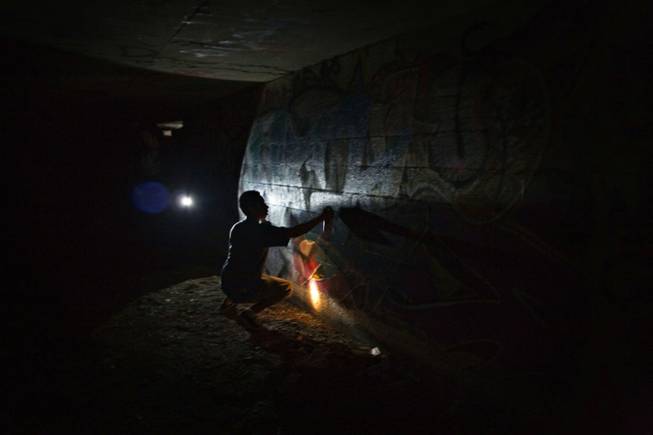
A graffiti artist paints by flashlight. “It’s a little bit creepy, because you’re in the dark and if your light goes out … you don’t know what you’re going to run into,” says an artist who goes by the name Kora.
Tuesday, May 27, 2008 | 2 a.m.
Storm Drain Gallery: Vegas' Graffiti Underground
For more than two decades graffiti writers from Las Vegas and beyond have been venturing almost a mile into the dark and dank storm drains under the glittering Las Vegas Strip to spray paint extravagant murals and quick scribbles in what has become Las Vegas' most intriguing art gallery. An unpredictable world lit only by the light they carry and occasional street grates, these graffiti writers find the fame by each other and the ever-present unknown of the storm drains.
Ruckus Reformed
Joshua Glover is a commercial graphic artist who owns his own business, creating photographs, illustrations and designs for the Las Vegas area. The graphic artist by day is also a tattoo artist by night. But, beneath all the mediums this artist works in, lies a self-proclaimed graffiti artist embedded in the hip-hop world. Glover shares his evolution from one of the city's first spray-can rebels to legitimate creative professional.
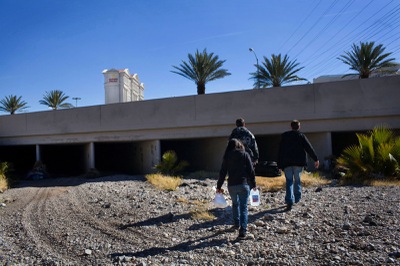
Friends head into the storm drains for a day of painting. Graffiti artists have a variety of reasons for turning to the dark tunnels under the Strip, but most agree it's nice to just be able to take their time and paint. Authorities say their priority is fighting graffiti painting in more visible locations.
The city’s most intriguing art gallery lives under Las Vegas Boulevard. It’s dark and it’s dirty. There are no formal openings. No curator. No reviews. No selling of the works.
The artists slip in and out. They do their work, then disappear from the underground concrete corridors. Runoff water pours from pipes into these toxic storm drains. Debris is everywhere. You’re glad you have thick shoes as you walk through water and muck. Sun shines through a few of the grates, lighting some areas, but most of what you see is what your flashlight catches.
It is the antithesis of the Strip above.
Artists have been spraying in these tunnels for at least two decades. Floor-to-ceiling works scream off the walls. Some are mindless scrawls or thoughtless tags. Others are refined formal works with solid clean lines, a visible thought process and overlapping textured forms that suggest styles of Georges Braque or Fernand Leger.
An incidental resurrection of style? A continuation of a movement? Hard to say. Most graffiti artists learn from their peers and many have never been to a museum.
Much of the work in the tunnels isn’t great, but some of it is mind-blowing. Vivid, clean abstract works, red, yellow and black with white outlines. It’s a labyrinth of letters mixed with bold fluorescent fonts and cartoon-style characters.
This is some of the best graffiti in town, only nobody will see it. The location of the work seems counterintuitive, considering the visibility and attention graffiti artists crave.
That doesn’t matter as much to these artists, who care more about the unlimited canvas and all the time in the world to hone their skills, despite the danger of flash floods, crime and the unknown.
“Nobody will never mess with you,” says 30-year-old Joshua Glover, aka Ruckus, a graphic designer who was among the first artists to paint in the storm drains. “You can’t even smell no paint because the tunnel goes on forever and ever. So let’s get it on. We got out there and we started painting.”
For some artists, the tunnels are a last resort. They’ve been arrested and locked up and need to lie low. Nobody has sympathy for someone destroying property. Nearly $30 million a year is spent on graffiti cleanup in the valley and taxpayers are footing the bill for government employees hired specifically to handle graffiti. Some bristle at the idea of graffiti being art. Cindy Lucas, code enforcement supervisor for the county’s graffiti program, deals with homeowners struggling with graffiti blight in their neighborhoods. “The difference between art and graffiti is permission,” Lucas says. “None of our guys have ever removed art, let’s put it that way.”
Ruckoh, who is of no relation to Ruckus, is a fresh-faced 18 year-old was locked up for burglary as a juvenile when a friend and fellow painter snitched on him. His fate was sealed by fingerprints from cans left behind and a 2-inch-thick book of the graffiti he’d been doing for the past year. (The county keeps a database of monikers that were photographed before they were removed.) His time at Caliente Youth Center straightened him up, he says. No more freeway signs, no more trailer yards, no more trains, no more buildings. He has a good job and can’t afford another arrest. He says he’s not harming anyone in the tunnels, even though it’s illegal and dangerous. He buys the most expensive paints for his tunnel productions, insisting still that there is no other high like a graffiti high.
New crews arrive all the time. Tags and murals dating to the ’80s line the dirty storm drains. Traffic ebbs and flows. Painters are paranoid, fearing that an approaching flashlight is Metro or someone looking for trouble. Mostly there aren’t problems between the painters and the homeless, but there are other concerns: bodies have been found down there.
Jonny Warren, aka Meow, 27, was “writing” the tunnels nearly 10 years ago, “There were so many kids coming and going,” he says. “Not really gangs in the tunnel, just the graffiti artists.”
Warren and his brother, Ed, had done trains, public and private property, the whole gamut. Sometimes he’d hit the tunnels in the middle of the night, “the best time to do it” because nobody is there. “You never know what’s going to happen, what’s going to come at you,” Warren says. “Then there were times I’ve gone in there one morning at 10 and didn’t come out until 8 or 9 at night. You just paint all day.”
Like Glover and other artists before him, Jonny Warren remembers the battles between various graffiti crews— artists covering other artists’ work, trying to outdo each other. “We were writing for each other or against each other,” he says. “It was more of a tight-knit clique of kids.”
Ed Warren would go into the tunnels with a crew armed with mining helmets, headlamps and paint cans and rollers to prime the porous walls, seal the dips. They worked all day on collaborative productions that they’d photograph and send to Web sites. One day an odor like spoiled raw chicken chased them out, and he spent the next five days vomiting. But he spent four years writing down there before quitting graffiti to raise his daughter.
Glover and the Warrens now opt for legal murals. Ed and Jonny Warren participate in murals behind the Attic, a trendy vintage clothing store on South Main Street. Attic owner Mayra Politis lets them paint the enclosed space behind the store. “It gives them a venue to do what they like to do instead of destroying and defacing property, which is what I hate,” she says.
Legal murals are now more commonplace in Las Vegas. Artist Iceberg Slick has never done graffiti, but sanctions legal graffiti events, such as art exhibits and murals. He says the legal murals let the public at large see what graffiti artists are capable of doing when they have permission.
“A lot of these kids do want validation as an artist,” says Slick, who talks to youth about graffiti artists who have turned their lives around and now design T-shirts or work as designers. “Kids who just want to destroy, I can’t do nothin’ with ’em.”
Arts Factory owner Wes Myles has commissioned several artists and crews to create murals in the Arts District.
Glover got tired of “rippin’ and runnin’ ” so he got his degree in graphic design and climbed the corporate ladder before opening his own company, eightyeight. He paints legal murals, including one on a building behind the Arts Factory that was used for the Samuel Beckett festival.
“Anytime I’m going to do a mural I’m going to use spray paint because I want people to understand spray cans as a medium,” Glover says. “Attitudes are changing toward graffiti, but people still have prejudice. They don’t understand it as an art form.”
That’s probably because, unlike in other cities, there is little great graffiti art in Las Vegas. Most of what you see is tagging. We’ve yet to turn out a thoughtful, conceptual artist like London’s Banksy.
Glover was about 10 when he watched older kids paint characters on a wall in a park in Chicago. A few months later he dropped a tag on a train in Las Vegas. He got better and wanted people to see his work. Surrounded by the hip-hop culture, he spent time absorbing graffiti while visiting his aunts in Los Angeles.
In the tunnels, he’d paint in the dark, couldn’t see his own hand. No flashlights. He prided himself in being sneaky. Word spread quickly about what he and his friends were doing.
“Everyone knew us for ‘burning’ (painting) pieces so everyone always made their way out there,” he says. “There was so much going on out there it became a full-blown runnin’ yard.”
Those who didn’t go to the tunnels saw the work via photographs shared at parties.
“We never got chased by cops, but cops didn’t even understand or know anything about how we were getting down there in the late ’80s early ’90s,” he says. “A couple security guards from Caesars would come in there. When we’d hear things; we’d become a ghost.”
The county says it’s concerned about underground grafitti, but the highest priority is that which is most visible.
In fact, little was known about the storm drains before Matt O’Brien’s “Beneath the Neon: Life and Death in the Tunnels of Las Vegas” was published last June. O’Brien returned to the tunnels over four years to chronicle the underground culture.
It’s been 10 years since Glover has been in the tunnels. He’s married 10 years and has two daughters.
As a designer who has worked with architects, he says he can’t imagine destroying property, painting illegal murals.
He can’t even guess what the walls look like today. Ten years is a long time for graffiti artists to make their mark, cover someone else’s work and brag about it later. It’s a long time, given the amount of foot traffic going through this otherwise quiet place. A new crew just discovered the tunnels within the past few weeks. Some artists stay clear, such as Jester, a prolific aerosol artist from Denver who has legal murals around town and doesn’t want to get arrested:
“No way could I go down there and do a piece. Everybody knows who I am.”
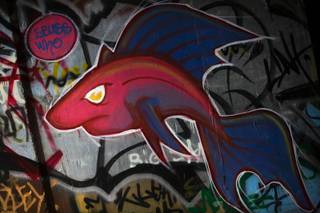

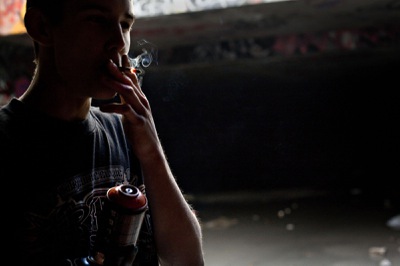
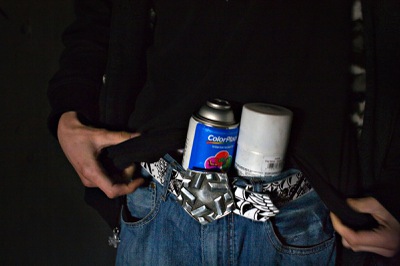
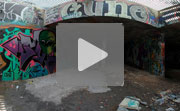

Join the Discussion:
Check this out for a full explanation of our conversion to the LiveFyre commenting system and instructions on how to sign up for an account.
Full comments policy